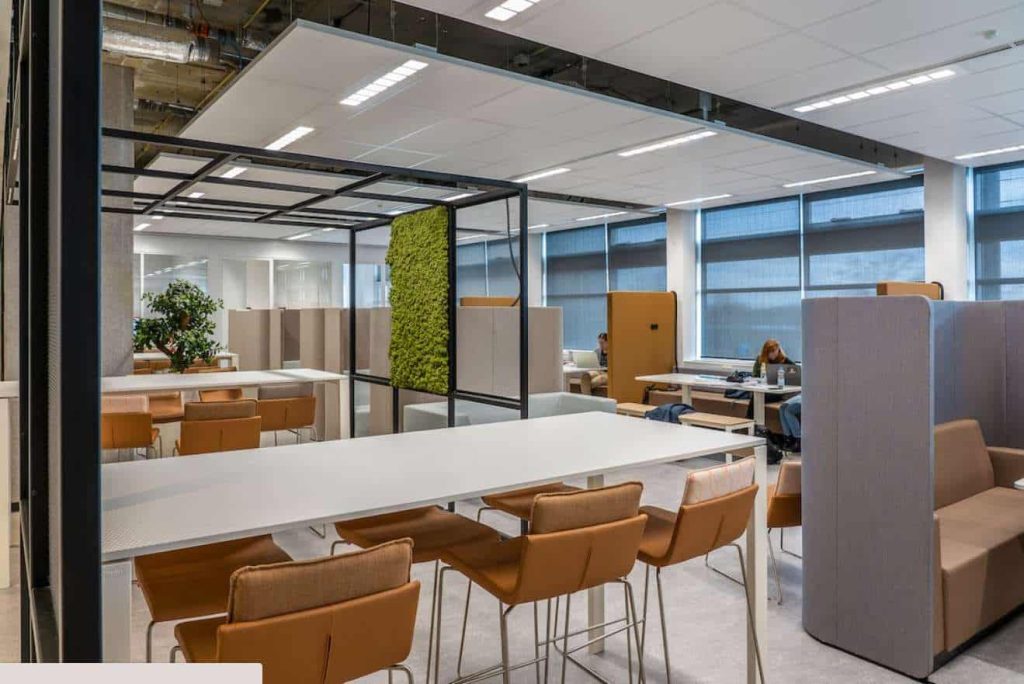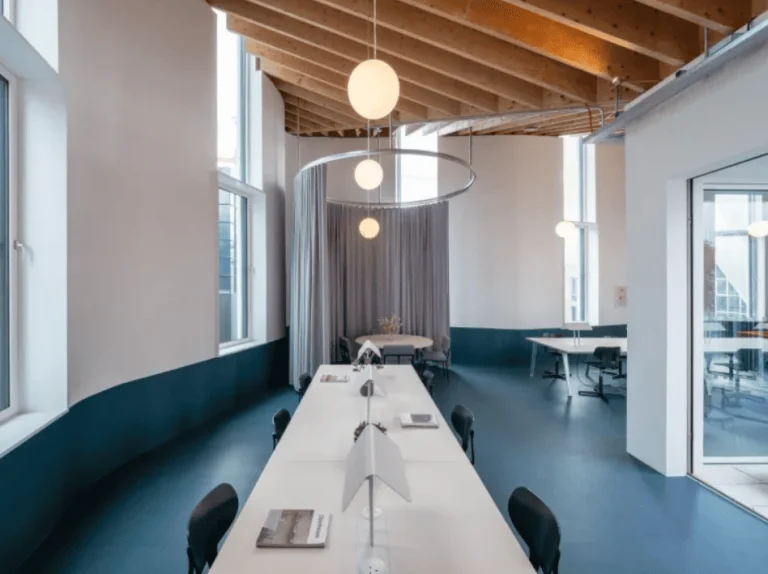What is Flexible Office Space?
Picture a workspace that adapts to your needs like a trusted companion, where the constraints of fixed and assigned desks are replaced with boundless opportunities. This is the essence of a flexible office space. Unlike the familiar structure of traditional offices, these innovative work environments redefine how and where we work. In a flexible office space, employees are liberated from the confines of designated seats, granting them the freedom to select their ideal workspace to match their specific tasks, fostering an atmosphere of productivity and creativity
The magic of flexible workspaces doesn’t stop at personalization. They possess the unique ability to transform swiftly, adjusting to the evolving objectives of businesses, and effortlessly accommodating teams of all sizes. These dynamic office settings harmonize seamlessly with flexible working arrangements, empowering teams to chart their own course—deciding not only where they work but when and how they work. As we delve deeper into this article, we will unveil the myriad advantages that flexible office spaces offer to the modern workforce, making work an enriching and dynamic experience for all.

Know More About Flexible Working
Flexible working is all about breaking free from the traditional 9-to-5 office grind. It means having the flexibility to work outside those usual office hours or locations. This could involve working from home, a remote desk, or adopting a part-time schedule.
The beauty of flexible working is that it makes life better for employees. No more stressing about rigid office hours or enduring long commutes. People can work where they’re most comfortable and at times that suit them. This freedom not only leads to happier employees but also more productive ones. It lets people juggle work with personal commitments, like doctor’s appointments and school runs, without the hassle of rush-hour traffic.
But it’s not just employees who benefit. Companies also find value in flexible working. It helps them save money and makes better use of office space. With fewer people in the office at one time, it’s easier to create collaborative spaces for teams to brainstorm and work together. At the same time, those who need a quiet spot to focus can find one. Flexible working is a win-win, reshaping how and where we work for the better.
Exploring Key Aspects of Flexible Workspaces
Flexible workspaces, often referred to as “flex office space,” are like chameleons in the world of office design. They shape-shift to cater to a company’s ever-evolving needs, resulting in a unique environment for each organization. However, amid this diversity, there are several fundamental elements that you’ll encounter in most flexible workspaces. These elements are carefully crafted to foster adaptability and collaboration, defining the essence of these dynamic environments.
1. Open-Plan Designs: While open-plan offices may seem like a modern innovation, their roots trace back over a century to New York City. However, the open-plan layouts we’re familiar with today gained prominence in the 1960s. Interior designers adopted this style to efficiently accommodate larger teams by removing physical barriers between employees. This concept has now become a hallmark of flexible workspaces, encouraging seamless collaboration among different departments.
2. Quiet Areas: Despite the benefits of open-plan design, it often brings along increased ambient noise. Flexible workspaces address this by carving out quiet zones where individuals can concentrate without disruptions. These areas come in various forms, from open quiet corners to sound-insulated phone booths, ensuring that focus and productivity remain undisturbed.
3. Adaptable Workstations: Flexible office spaces are known for their non-traditional workstation setups. You’ll find standing desks in communal areas, promoting the idea of fluidly utilizing space in various ways. Cozy nooks, like coffee bars and reception areas, feature comfortable seating and abundant natural light, creating inviting and flexible spaces where people can work comfortably.
4. Shared Amenities: In traditional offices, employees tend to accumulate resources around their desks. Flexible workspaces centralize these resources, making them accessible to everyone. Shared amenities encompass office supplies, printers, snacks, and even entire spaces like conference rooms or casual common areas, facilitating a more efficient and collaborative work environment.
These essential components, woven into the fabric of flexible workspaces, lay the foundation for agility and innovation in the modern workplace. They transform offices from static settings into dynamic, adaptable spaces where creativity and productivity flourish.
Also read: What is Coworking?
Advantages of Flexible Office Space
Flexible workspaces have emerged as a beacon of modern work culture, erasing the barriers that traditional office spaces once imposed on productivity. Consider the typical journey of a project, commencing with informal face-to-face meetings among a small team, progressing to structured discussions, and then branching into smaller groups or solitary tasks.
In a traditional office setting, all these stages are confined to fixed locations, despite the evolving space needs of the project. However, the beauty of a flexible office space lies in its adaptability. Here, individuals have the freedom to choose a workstation that aligns perfectly with their current task. It might entail working on a laptop in a tranquil corner, enabling deep concentration, or utilizing a relaxed communal space to catch up with fellow team leaders over a steaming cup of coffee. Some days, it might even mean working remotely, unburdened by the confines of a physical office. This flexibility offers employees the breathing room they need to deliver their best work on their own terms.
For business owners, the merits of flexible workspaces extend beyond mere productivity gains. Adaptable office layouts empower agile workplace companies to seamlessly expand during growth phases or downsize when fewer employees occupy the office. Dynamic spaces, easily reconfigured, play a crucial role in designing socially distanced office layouts, addressing the imperative of worker safety in today’s world. Furthermore, flexible offices can be operated closer to maximum occupancy, effectively reducing lease costs, and delivering a cost-efficient solution.
Incorporating flexible workspaces into the modern work ecosystem not only enhances productivity but also offers a strategic edge, allowing businesses to navigate the ever-shifting tides of the contemporary workplace landscape with agility and ease.
The Significance of Office Layout
The COVID-19 pandemic has brought the design and layout of our public spaces into sharp focus. The way we navigate our cities has shifted, and as we gradually reintegrate into bars, restaurants, gyms, and offices, our approach to indoor spaces is evolving as well.
In response to social distancing guidelines, most workplaces have undergone transformations, from desk layout reconfigurations to enhanced cleaning protocols and the implementation of one-way traffic systems. Flexible office spaces have emerged as a valuable solution, allowing businesses to meet this challenge with minimal disruption. They offer the flexibility for teams to spread out over a larger area or to work remotely, aligning seamlessly with the new normal.
Looking beyond the pandemic, a well-thought-out office layout is one that prioritizes safety, comfort, and functionality. Flexible office spaces, in particular, play a pivotal role in enhancing productivity by granting teams access to shared spaces and essential resources. When employees are supported by an office design that nurtures creativity and adapts to their evolving needs, whether over the course of a project or a day, it becomes notably easier to achieve their goals.
The design and layout of office spaces are no longer mere aesthetic considerations but fundamental elements that shape the modern work experience. Flexible office spaces are at the forefront, offering versatility and adaptability in an ever-changing landscape, ensuring that work environments remain safe, comfortable, and conducive to achieving objectives.
Also Read: What is a Satellite Office?
Implementing Flexibility in Your Office Space
Creating a flexible office space involves more than just adding beanbag chairs next to the coffee machine. It’s about fostering an agile work environment, one that encourages employees to utilize different areas of the office as needed. While altering the office layout is the easier part, reshaping the office culture poses a more substantial challenge.
Begin by de-formalizing spaces that are traditionally designated for singular purposes. For instance, that formal conference room, typically reserved for monthly debriefs, might find a new purpose as an activity-based work area or a quiet spot for focused email catch-up. Meeting pods and comfortable furniture can seamlessly create serene zones within open-plan offices, eliminating the need for clunky room dividers.
Technology is a crucial ally in the realm of flexible office design. Ensure that there are easily accessible outlets for charging devices near most seats and a robust mesh network providing wireless data connectivity in every corner of the office. Standardizing the audiovisual setup for presentations across various rooms streamlines the process, making it effortless to host meetings in any part of the office.
We humans are creatures of habit, and adapting to a new way of working can take time. However, by introducing versatile spaces and remaining responsive to how your teams utilize them, you can gradually unlock the full potential of flexible office design. This evolution not only reshapes the physical aspects of the workplace but also transforms the very fabric of office culture, making it more adaptive and efficient for the future.






